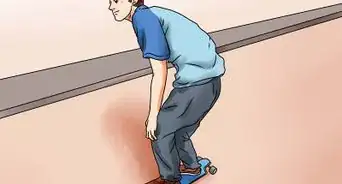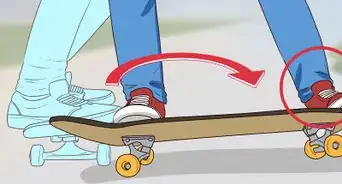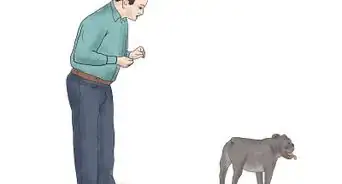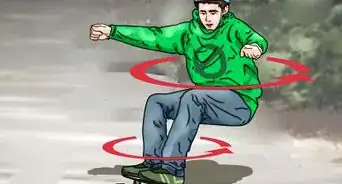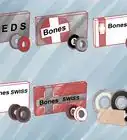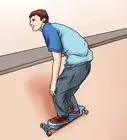This article was co-authored by Jon Depoian. Jon Depoian is a Skateboarding Instructor and the Owner of Intro2Skateboarding, an organization based in Orange County, California that provides professional private, home-school, after-school, birthday party, and summer camp skateboard lessons for beginners and experienced skateboarders alike. Jon has over 21 years of skateboarding experience and over 10 years of skateboard instruction experience. He also has extensive experience producing street skateboarding videos and skating competitions.
wikiHow marks an article as reader-approved once it receives enough positive feedback. This article received 30 testimonials and 97% of readers who voted found it helpful, earning it our reader-approved status.
This article has been viewed 528,808 times.
Everybody has to start somewhere. If you want to learn to skateboard, but don't know an ollie from an elbow, you've come to the right place. You can learn to get the right gear for learning to skate, learn to stand on the board and ride comfortably without falling down, and some helpful hints for sticking with it and actually learning to ride. See Step 1 for more information.
Steps
Basic Techniques
-
1Try standing on the board without falling down. There's no right way to stand on the board, so set the board on stable ground, like the grass or even carpet, where it won't roll easily, and figure out what feels most comfortable for you. Put one foot in front of the other, lined up roughly with the truck screws.[1]
- Regular foot means you've got your left foot forward your right foot. Generally, this means you'll push with your right foot and ride with your left.
- Goofy foot means you've got your right foot forward, meaning you'll push with your left. Despite the name, there's nothing "unusual" about this stance. It's just as common as regular footedness.
- Mongo foot is more unusual, and refers to a riding stance in which the forward foot is the foot used to push. It may feel natural for you at first, but don't make it a habit. Riding mongo creates an awkward motion of swinging your foot forward which can limit your capabilities with tricks. You also run a much higher risk of the board slipping out forward from under you.
-
2Try to push off. On some level concrete, stand on the board with your forward foot and use a long, even step with your back foot to create momentum.
- When beginners start, they often tend to take several short "stabs" before getting started, rather than long pushes. You want to use a longer sweeping push off, which will make the ride smoother and ensure that you'll stay balanced.
Advertisement -
3Shift into the riding position. When you get moving, you need to shift your riding foot sideways, more like how you were standing when you had the board still on the grass, and bring your pushing foot up to rest lightly on the fishtail at the back of the board. Your knees should be slightly bent, but you should be generally standing upright, with a straight back, to learn to balance correctly.[2]
- In a proper riding stance, your forward foot should be just behind or on the front truck screws, and your back foot should be near the back of your board, near or on the tail. This is the most stable and safe riding stance, and having your back foot already on the tail makes a quick kickturn easier.
- This is the most difficult thing to learn when you're first getting started, but the good news is you'll be riding successfully when you get it figured out! No fear!
-
4Learn to turn. To turn, you'll shift your weight forward or back from the ankle, depending on your stance and whether or not you want to go right or left. The amount of pressure you'll use will depend on how tight your trucks are and how far you want to turn. Practice on level surface, getting started, shifting into your riding stance, and then executing a turn safely without falling off. This type of turning is the most common and is referred to as carving.[3]
- To quickly avoid something or make a tight turn that carving can't reach, kickturning is a very valuable skill. With your back foot, apply a slight pressure to the tail (to lift the front wheels slightly off the ground) and pivot your body in the direction you want to turn. This should be done in one motion. Be careful not to put too much pressure on the tail or you risk the board slipping out from under you. Also, it's probably not a very good idea to do this while speeding downhill.
-
5Try to stop. There are lots of different ways to stop a skateboard, and many of them are more advanced. For the beginner, the easiest way is usually to either gradually slow down, and stop by putting a foot to the pavement, or to execute a tail stop.
- To tail stop, you'll shift most of your weight onto your back foot, standing on the tail of the board, and grind the board to a stop with the tail. Some people don't like doing this because it wears down the back tail, but many skateboards, especially flat cruising models, have a plastic stopper designed for helping you stop, making it a good option for beginners.
-
6Forget about tricks. The biggest thing that keeps beginners from actually learning how to skate is wanting to jump straight to performing ollies before learning the fundamentals. You'll get there, with practice, but like you've got to learn to play a simple guitar chord before you learn to melt faces with tapping solos, you've got to learn to push the board and ride it comfortably. You've got to learn to stay on the board before you start jumping with it.[4]
Ways to Improve
-
1Learn to fall. No skater has ever not fallen off the board. It can be discouraging, but learning to fall properly can help make sure you don't seriously hurt yourself. Always wear a helmet, to keep your head safe, and try to use wrist guards, which you can use to take the brunt of most falls and avoid the nasty scrapes that are part of the skating world.
- The most common problem is usually running over small pebbles that jam up the wheels, or hitting a crack that suddenly causes you to lose your balance. Keep a close eye on the terrain as you're skating, but keep your eyes up to stay balanced as much as possible.
-
2Skate with other skaters. Like music and other sports, skating is easiest to learn when you have good people to learn from. Hook up with more experienced skaters to watch and learn all you can, picking up tips and tricks along the way. Ask for advice and be honest about your experience.
- Make sure you don't get suckered into trying something you're not ready for. If you go out skating with a bunch of dudes ollieing down a flight of stairs, you could wind up seriously hurting yourself if you're just trying to learn how to stop without falling down. Go slowly. You'll get there eventually.
-
3Watch lots of skating videos. Skating videos are at the heart of skating culture. Compilation videos and tutorials are widely available for free on the Internet. You can find virtuosic displays of skating prowess, as well as helpful hints and tips for the beginner. For example, Aaron Kyro and Andy Schrock have good tutorials and information on their channels. Learn how to do more advanced technical things and tricks with videos.
-
4Try skating downhill. Letting gravity help you along the way is an important step in beaming a more advanced skater. It can be scary the first time you start going downhill and don't have to push, so learning to work with it and stay in control of your board is a good thing to learn early on.
- To stay balanced, crouch lower on the board and use your arms to stay from swaying side to side. Keep your ankles as still as possible, because at higher speeds smaller movements create bigger swings, making it more likely you'll lose your balance.
-
5Try tricks when you're ready. When you start getting comfortable on the board and can stay on it regularly without falling down, you might be ready to start trying a trick or two. It's what you've been building toward after all! The best and easiest tricks for beginners are:
-
6Keep skating. Stick with it! Learning to skateboard well takes time and effort. It's not something you'll be able to learn overnight, but by taking it slowly and practicing as much as you can, you'll improve and get more comfortable on the board. Try not to get discouraged.
Gear Selection and Setup
-
1Get a board that suits your interests. There are lots of styles and brands of boards available for all skill levels and interests. Visit a local skate shop to browse the selection and get advice from more experienced skaters in choosing a skateboard that's appropriate for your size and desires from your board:
- Longboards are great for cruising and easy for beginners to maneuver. If you're interested in something that will be easy to hop right on and go, or something to get you from place to place, a longboard is definitely the way to go. They're not great for tricks, so if you're interested in popping ollies, it's not the best option.
- Skateboards are what you think when you think "skateboard." With tapered ends perfect for kicking tricks and jumps, and easy soft maneuverability, these boards are excellent for skating around at quick speeds, though they'll take a little more practice to get balanced when you're first starting out. If you want to eventually drop into a half-pipe, though, this is the board for you.
- Custom boards are built and assembled yourself with basic tools. Generally, more experienced skaters will choose their wheels, trucks, bearings, and deck separately from the options available. This is good to choose the best brand of each component, whereas a pre-built board may have one or two bad components in specific.
-
2Make sure your board is set up correctly for a beginner. You don't want a super-curved board and loose trucks when you're first starting out. While those kinds of features might be great for doing tricks, they're much more difficult to stay balanced while riding upon, making it unlikely that you'll stick to it, if you can't learn to stay on the board. You want a relatively flat board with tight trucks to learn on. You can loosen the trucks later, when you can control speed wobble.
-
3Get a pair of good skate shoes. Trying to hop on your board with combat boots or flip-flops is a good way to hurt yourself or twist an ankle. Skate shoes have the right kind of sole to grip the board and ensure both protection and support, making them ideal for learning to skate. Vans, Airwalk, DC's, and Etnies are all signature skate shoes, though plenty of athletic companies now make shoes perfect for skating.
- If you're not able to find a particular skating brand, what you want is a flat sole. Avoid the kind of textured tread common for tennis or running shoes, and instead go for something more like a deck shoe, with an even and flat surface on the bottom.
-
4Always wear protective gear and a helmet. It's absolutely essential that you get a skating helmet, which features a smooth surface and a snug chin strap to protect your head. It's likely you'll fall a lot, so it's very important that you ensure your safety and wear a helmet. Some even look pretty cool![5]
- Additionally, knee pads, wrist guards, and elbow pads are also the common protective gear to wear, especially when you're first getting started. When you get more comfortable on the board, you'll probably not need to wear all the pads every time you want to skate, but anytime you're learning a new trick, and especially when you're first learning to stay on the board, extra pads are a very good idea.
- There's nothing dorky about avoiding expensive trips to the emergency room, especially when you're first starting out. Don't let anyone tell you that "real skaters" don't use protective gear, which is an immature, foolish, and flat-out wrong. Besides, a helmet is cooler than permanent brain damage.
-
5Find a good place to skate. Ideally, you'll want smooth concrete, without many bumps and cracks that'll jostle you as you're trying to learn to move. Eventually, you'll be able to skate over uneven surfaces safely, but it's easiest to learn in a parking lot or driveway that's mostly flat and even.
- It's unfortunately harder and harder to find places that welcome skateboarders, given the unfair reputation skateboarding has in some towns. Don't be a skater that gives law-abiding boarders a bad name: make sure you've got permission to skate when you're skating, and avoid scuffing up property that doesn't belong to you.
Expert Q&A
Did you know you can get expert answers for this article?
Unlock expert answers by supporting wikiHow
-
QuestionHow do beginners learn to skate? What's the first thing I should do?
 Jon DepoianJon Depoian is a Skateboarding Instructor and the Owner of Intro2Skateboarding, an organization based in Orange County, California that provides professional private, home-school, after-school, birthday party, and summer camp skateboard lessons for beginners and experienced skateboarders alike. Jon has over 21 years of skateboarding experience and over 10 years of skateboard instruction experience. He also has extensive experience producing street skateboarding videos and skating competitions.
Jon DepoianJon Depoian is a Skateboarding Instructor and the Owner of Intro2Skateboarding, an organization based in Orange County, California that provides professional private, home-school, after-school, birthday party, and summer camp skateboard lessons for beginners and experienced skateboarders alike. Jon has over 21 years of skateboarding experience and over 10 years of skateboard instruction experience. He also has extensive experience producing street skateboarding videos and skating competitions.
Skateboarding Instructor It's really essential that you learn how to get on and off of the skateboard first. I'd recommend putting the board in the grass or dirt and just get used to putting one foot on, bringing your other foot up, and balancing on the deck. Once you're comfortable with that you can start trying to actually ride.
It's really essential that you learn how to get on and off of the skateboard first. I'd recommend putting the board in the grass or dirt and just get used to putting one foot on, bringing your other foot up, and balancing on the deck. Once you're comfortable with that you can start trying to actually ride. -
QuestionWhat is a good skateboard for a beginner?
 Jon DepoianJon Depoian is a Skateboarding Instructor and the Owner of Intro2Skateboarding, an organization based in Orange County, California that provides professional private, home-school, after-school, birthday party, and summer camp skateboard lessons for beginners and experienced skateboarders alike. Jon has over 21 years of skateboarding experience and over 10 years of skateboard instruction experience. He also has extensive experience producing street skateboarding videos and skating competitions.
Jon DepoianJon Depoian is a Skateboarding Instructor and the Owner of Intro2Skateboarding, an organization based in Orange County, California that provides professional private, home-school, after-school, birthday party, and summer camp skateboard lessons for beginners and experienced skateboarders alike. Jon has over 21 years of skateboarding experience and over 10 years of skateboard instruction experience. He also has extensive experience producing street skateboarding videos and skating competitions.
Skateboarding Instructor Any large board is going to be a lot easier to balance on, so I'd recommend you get something on the bigger side when you're starting out. Choose your wheels based on what you're planning to use the board for. Harder wheels won't be as smooth, but they'll give you more freedom to do tricks in the future. Softer wheels will result in a smoother ride, but it's a lot harder to do anything fancy on the board with soft wheels.
Any large board is going to be a lot easier to balance on, so I'd recommend you get something on the bigger side when you're starting out. Choose your wheels based on what you're planning to use the board for. Harder wheels won't be as smooth, but they'll give you more freedom to do tricks in the future. Softer wheels will result in a smoother ride, but it's a lot harder to do anything fancy on the board with soft wheels. -
QuestionWhat's the best way to stop on a skateboard?
 Jon DepoianJon Depoian is a Skateboarding Instructor and the Owner of Intro2Skateboarding, an organization based in Orange County, California that provides professional private, home-school, after-school, birthday party, and summer camp skateboard lessons for beginners and experienced skateboarders alike. Jon has over 21 years of skateboarding experience and over 10 years of skateboard instruction experience. He also has extensive experience producing street skateboarding videos and skating competitions.
Jon DepoianJon Depoian is a Skateboarding Instructor and the Owner of Intro2Skateboarding, an organization based in Orange County, California that provides professional private, home-school, after-school, birthday party, and summer camp skateboard lessons for beginners and experienced skateboarders alike. Jon has over 21 years of skateboarding experience and over 10 years of skateboard instruction experience. He also has extensive experience producing street skateboarding videos and skating competitions.
Skateboarding Instructor The most common option is to take your back foot off of the board, bring it forward a bit, and slowly lower it to the ground to generate friction and slow down. Alternatively, instead of just slowing to a crawl with your foot on the ground, you can always walk or run off of the board once you've slowed down.
The most common option is to take your back foot off of the board, bring it forward a bit, and slowly lower it to the ground to generate friction and slow down. Alternatively, instead of just slowing to a crawl with your foot on the ground, you can always walk or run off of the board once you've slowed down.
Warnings
- Always use protective gear (helmets and pads) and skate with another person. You can get seriously injured while pulling stunts or falling on concrete if you're not cautious--especially as a beginner.⧼thumbs_response⧽
- Watch out for those skaters that think they're good when they're really not. They will put themselves and you in danger, so be careful.⧼thumbs_response⧽
- Don't skateboard in places where it's prohibited by signs.⧼thumbs_response⧽
References
- ↑ Jon Depoian. Skateboarding Instructor. Expert Interview. 5 June 2020.
- ↑ http://www.board-crazy.co.uk/skateboarding_beginners_1.php
- ↑ Jon Depoian. Skateboarding Instructor. Expert Interview. 5 June 2020.
- ↑ Jon Depoian. Skateboarding Instructor. Expert Interview. 5 June 2020.
- ↑ Jon Depoian. Skateboarding Instructor. Expert Interview. 5 June 2020.
- https://www.youtube.com/watch?v=-IN8C101wyU
About This Article
To skateboard as a beginner, start by standing on your skateboard with one foot in front of the other. Then, push off with a long step from your back foot. As you start moving, turn your front foot sideways and rest your pushing foot on the back of the board. Additionally, keep your back straight to maintain good balance. If you want to turn, lightly touch the back of the board with your back foot to lift the front wheels slightly, and pivot your body in the direction you want to go. For tips on how to turn or stop your skateboard, keep reading!


-Step-13-Version-4.webp)
-Step-14-Version-3.webp)
-Step-15-Version-4.webp)
-Step-16-Version-4.webp)
-Step-17-Version-4.webp)


